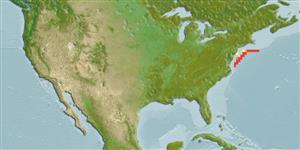Teleostei (teleosts) >
Lophiiformes (Anglerfishes) >
Chaunacidae (Sea toads o coffinfishes)
Etymology: Chaunax: Greek, chaunax, -akos = a conceited man (Ref. 45335); stigmaeus: Specific name mean 'spotted' (Ref. 33606).
More on author: Fowler.
Environment: milieu / climate zone / depth range / distribution range
Ecology
Marine; bathydemersal; depth range 90 - 730 m (Ref. 7251). Deep-water; 40°N - 36°N
Western Atlantic: Georges Bank to Norfolk Canyon.
Size / Weight / Age
Maturity: Lm ? range ? - ? cm
Max length : 30.5 cm TL male/unsexed; (Ref. 58471); common length : 20.0 cm TL male/unsexed; (Ref. 7251)
One of the specimens (NCSM 41116) represents a new size record for the species (25.5 cm SL, 30.5 cm TL), and another (GMBL 02788) represents a southerly range extension (31°23.94'N). All specimens observed exhibited similar behaviors of sitting on the bottom on top of dense beds of dead coral (Lophelia pertusa) (Ref. 58471).
Life cycle and mating behavior
Maturity | Reproduction | Spawning | Eggs | Fecundity | Larvae
Robins, C.R. and G.C. Ray, 1986. A field guide to Atlantic coast fishes of North America. Houghton Mifflin Company, Boston, U.S.A. 354 p. (Ref. 7251)
IUCN Red List Status (Ref. 130435: Version 2024-1)
Threat to humans
Harmless
Human uses
Tools
Special reports
Download XML
Internet sources
Estimates based on models
Preferred temperature (Ref.
123201): 4.5 - 14.7, mean 10.5 °C (based on 9 cells).
Phylogenetic diversity index (Ref.
82804): PD
50 = 0.5000 [Uniqueness, from 0.5 = low to 2.0 = high].
Bayesian length-weight: a=0.01000 (0.00244 - 0.04107), b=3.04 (2.81 - 3.27), in cm total length, based on all LWR estimates for this body shape (Ref.
93245).
Trophic level (Ref.
69278): 4.2 ±0.7 se; based on size and trophs of closest relatives
Fishing Vulnerability (Ref.
59153): Low vulnerability (21 of 100).
